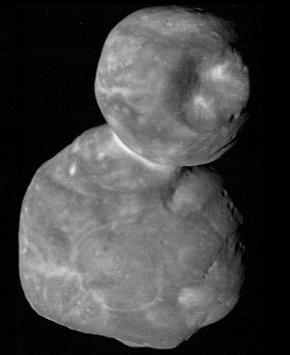 Grayscale composite image of Arrokoth | |||||||||
| Discovery [1][2] | |||||||||
|---|---|---|---|---|---|---|---|---|---|
| Discovered by | |||||||||
| Discovery site | Hubble Space Telescope | ||||||||
| Discovery date | 26 June 2014 | ||||||||
| Designations | |||||||||
| (486958) Arrokoth | |||||||||
| Pronunciation | /ˈærəkɒθ/ | ||||||||
Named after | Powhatan word arrokoth, glossed 'sky' but probably meaning 'cloud' | ||||||||
| |||||||||
| Orbital characteristics[2][5] | |||||||||
| Epoch 27 April 2019 (JD 2458600.5) | |||||||||
| Uncertainty parameter 2 | |||||||||
| Observation arc | 2.33 yr (851 days) | ||||||||
| Aphelion | 46.442 AU | ||||||||
| Perihelion | 42.721 AU | ||||||||
| 44.581 AU | |||||||||
| Eccentricity | 0.04172 | ||||||||
| 297.67 yr | |||||||||
| 316.551° | |||||||||
| 0° 0m 11.92s / day | |||||||||
| Inclination | 2.4512° | ||||||||
| 158.998° | |||||||||
| 174.418° | |||||||||
| Physical characteristics | |||||||||
| Dimensions | Overall best fit: 35.95 × 19.90 × 9.75 km[6] Wenu 21.20 × 19.90 × 9.05 km[6] Weeyo 15.75 × 13.85 × 9.75 km[6] | ||||||||
| Overall volume equivalent: 18.26 km[6] Wenu 15.86 km[6] Weeyo 12.79 km[6] | |||||||||
| Volume | 3185 km3[6] | ||||||||
| Mass | ~ 7.485×1014 kg (assumed nominal density)[6] | ||||||||
Mean density | ~ 0.235 g/cm3 (nominal) 1-sigma range: 0.155–0.600 g/cm3[6] | ||||||||
Equatorial surface gravity | ~ 0.0001 g ~ 0.001 m/s2[7]: 28:45 | ||||||||
| 15.9380±0.0005 h[8] | |||||||||
| 99.3°[9] | |||||||||
North pole right ascension | 317.5°±1°[10] | ||||||||
North pole declination | −24.89°±1°[10][9] | ||||||||
| 0.21+0.05 −0.04 (geometric)[11] 0.062±0.015 (Bond)[11] | |||||||||
| |||||||||
| V−I=1.35[12] G−I=1.42±0.14[13] G−R=0.95±0.14[13] | |||||||||
| 26.6[12] | |||||||||
486958 Arrokoth (provisional designation 2014 MU69; formerly nicknamed Ultima Thule[a]) is a trans-Neptunian object located in the Kuiper belt. Arrokoth became the farthest and most primitive object in the Solar System visited by a spacecraft when the NASA space probe New Horizons conducted a flyby on 1 January 2019.[17][18][19] Arrokoth is a contact binary 36 km (22 mi) long, composed of two planetesimals 21 and 15 km (13 and 9 mi) across, that are joined along their major axes. With an orbital period of about 298 years and a low orbital inclination and eccentricity, Arrokoth is classified as a cold classical Kuiper belt object.
Arrokoth was discovered on 26 June 2014 by astronomer Marc Buie and the New Horizons Search Team using the Hubble Space Telescope as part of a search for a Kuiper-belt object for New Horizons to target in its first extended mission; it was chosen over two other candidates, 2014 OS393 and 2014 PN70, to become the primary target of the mission.[20]
- ^ a b Cite error: The named reference
jpldatawas invoked but never defined (see the help page). - ^ a b c Cite error: The named reference
MPC-objectwas invoked but never defined (see the help page). - ^ Cite error: The named reference
Ultima Thulewas invoked but never defined (see the help page). - ^ Cite error: The named reference
Buie-DESwas invoked but never defined (see the help page). - ^ Cite error: The named reference
MPC-486958was invoked but never defined (see the help page). - ^ a b c d e f g h i Cite error: The named reference
Keane2022was invoked but never defined (see the help page). - ^ Cite error: The named reference
LPSC-2019-03-21was invoked but never defined (see the help page). - ^ Cite error: The named reference
Buie2020was invoked but never defined (see the help page). - ^ a b Cite error: The named reference
EPSC-DPS2019-311was invoked but never defined (see the help page). - ^ a b Cite error: The named reference
aay3999was invoked but never defined (see the help page). - ^ a b c Cite error: The named reference
Hofgartner2020was invoked but never defined (see the help page). - ^ a b Cite error: The named reference
Benecchi2019bwas invoked but never defined (see the help page). - ^ a b Cite error: The named reference
Thirouin2019was invoked but never defined (see the help page). - ^ "Thule". Oxford English Dictionary (Online ed.). Oxford University Press. September 2022. Retrieved 29 December 2020. (Subscription or participating institution membership required.)
- ^ "New Horizons Press Kit" (PDF). Applied Physics Laboratory. December 2018. p. 5. Retrieved 1 January 2019.
- ^ "New Horizons: First Images of Ultima Thule". YouTube. Applied Physics Laboratory. 1 January 2019. Archived from the original on 14 November 2021.
- ^ Cite error: The named reference
exploredwas invoked but never defined (see the help page). - ^ Cite error: The named reference
aboutwas invoked but never defined (see the help page). - ^ Cite error: The named reference
LPSC1611was invoked but never defined (see the help page). - ^ Cite error: The named reference
lauer-sciamwas invoked but never defined (see the help page).
Cite error: There are <ref group=lower-alpha> tags or {{efn}} templates on this page, but the references will not show without a {{reflist|group=lower-alpha}} template or {{notelist}} template (see the help page).